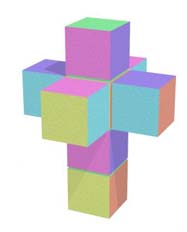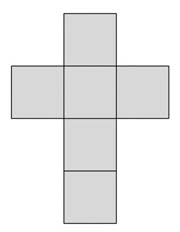If we unfold a hypercube, should the cubes not disappear upon making the identifications?
The six squares in a net of the cube are the six faces of the cube and the eight cubes in a net of the hypercube represent the “cubic faces” of the hypercube. In other words, the eight cubes represent the “exterior” of the hypercube, that is to say, what you should “see” of the hypercube in four-dimensional space.
On the other hand, if we imagine to glue the faces of the cubes two by two (as required by a net) , the faces should not be visible any more and not even the cubes! But if you can not see the eight cubes, where is the hypercube?
This time, the analogy is extremely difficult since we must study not only the three-dimensional analogue, but we must also suppose that we are “two-dimensional” observers. More specifically, we must imagine that we are two-dimensional beings who live on a plane where you find two squares, each of them with three black edges and one red edge.
Now, let us suppose that the two squares are glued red edge by red edge. We should see the exterior of a rectangle with four black edges; the red edge would disappear from our sight! But if you raise your head from the plane, you can still see the red edge.
Likewise, if two cubes have a face in common in four-dimensional space, you can still see this face (it is “external”). In particular, you can still see each face of the eight cubes in four-dimensional space although they are glued face by face.

